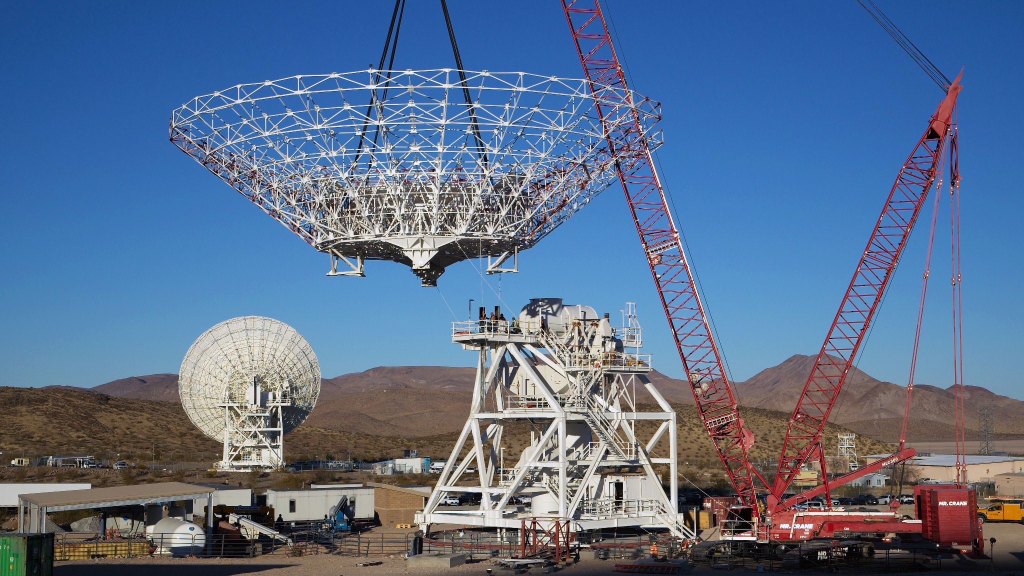4 min read
Preparations for Next Moonwalk Simulations Underway (and Underwater)
Deep Space Station 23’s 133-ton reflector dish was recently installed, marking a key step in strengthening NASA’s Deep Space Network.
NASA’s Deep Space Network, an array of giant radio antennas, allows agency missions to track, send commands to, and receive scientific data from spacecraft venturing to the Moon and beyond. NASA is adding a new antenna, bringing the total to 15, to support increased demand for the world’s largest and most sensitive radio frequency telecommunication system.
Installation of the latest antenna took place on Dec. 18, when teams at NASA’s Goldstone Deep Space Communications Complex near Barstow, California, installed the metal reflector framework for Deep Space Station 23, a multifrequency beam-waveguide antenna. When operational in 2026, Deep Space Station 23 will receive transmissions from missions such as Perseverance, Psyche, Europa Clipper, Voyager 1, and a growing fleet of future human and robotic spacecraft in deep space.
“This addition to the Deep Space Network represents a crucial communication upgrade for the agency,” said Kevin Coggins, deputy associate administrator of NASA’s SCaN (Space Communications and Navigation) program. “The communications infrastructure has been in continuous operation since its creation in 1963, and with this upgrade we are ensuring NASA is ready to support the growing number of missions exploring the Moon, Mars, and beyond.”
This time-lapse video shows the entire day of construction activities for the Deep Space Station 23 antenna at the NASA Deep Space Network’s Goldstone Space Communications Complex near Barstow, California, on Dec. 18. NASA/JPL-Caltech
Construction of the new antenna has been under way for more than four years, and during the installation, teams used a crawler crane to lower the 133-ton metal skeleton of the 112-foot-wide (34-meter-wide) parabolic reflector before it was bolted to a 65-foot-high (20-meter-high) alidade, a platform above the antenna’s pedestal that will steer the reflector during operations.
“One of the biggest challenges facing us during the lift was to ensure that 40 bolt-holes were perfectly aligned between the structure and alidade,” said Germaine Aziz, systems engineer, Deep Space Network Aperture Enhancement Program of NASA’s Jet Propulsion Laboratory in Southern California. “This required a meticulous emphasis on alignment prior to the lift to guarantee everything went smoothly on the day.”
Following the main lift, engineers carried out a lighter lift to place a quadripod, a four-legged support structure weighing 16 1/2 tons, onto the center of the upward-facing reflector. The quadripod features a curved subreflector that will direct radio frequency signals from deep space that bounce off the main reflector into the antenna’s pedestal, where the antenna’s receivers are housed.
Engineers will now work to fit panels onto the steel skeleton to create a curved surface to reflect radio frequency signals. Once complete, Deep Space Station 23 will be the fifth of six new beam-waveguide antennas to join the network, following Deep Space Station 53, which was added at the Deep Space Network’s Madrid complex in 2022.
“With the Deep Space Network, we are able to explore the Martian landscape with our rovers, see the James Webb Space Telescope’s stunning cosmic observations, and so much more,” said Laurie Leshin, director of JPL. “The network enables over 40 deep space missions, including the farthest human-made objects in the universe, Voyager 1 and 2. With upgrades like these, the network will continue to support humanity’s exploration of our solar system and beyond, enabling groundbreaking science and discovery far into the future.”
NASA’s Deep Space Network is managed by JPL, with the oversight of NASA’s SCaN Program. More than 100 NASA and non-NASA missions rely on the Deep Space Network and Near Space Network, including supporting astronauts aboard the International Space Station and future Artemis missions, monitoring Earth’s weather and the effects of climate change, supporting lunar exploration, and uncovering the solar system and beyond.
For more information about the Deep Space Network, visit:
https://www.nasa.gov/communicating-with-missions/dsn
News Media Contact
Ian J. O’Neill
Jet Propulsion Laboratory, Pasadena, Calif.
818-354-2649
ian.j.oneill@jpl.nasa.gov
2024-179





Leave a Reply
You must be logged in to post a comment.